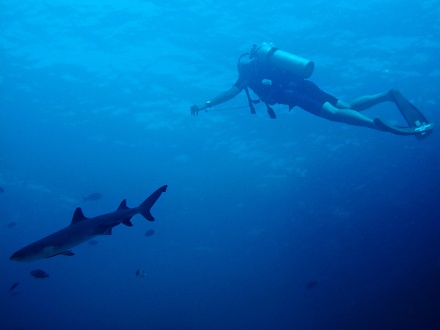Sharks in the Philipines: Tourism
Stamps Howard,Shark Tourism in the Philippines
 Sharks play a very important role in the tourism industry in the Philippines,
providing significant economic benefit to the local economy, and to The Philippines
economy as a whole.
Sharks play a very important role in the tourism industry in the Philippines,
providing significant economic benefit to the local economy, and to The Philippines
economy as a whole.
Whale Sharks in Donsol
The fishermen who once targeted whale sharks in the Donsol region have been retrained as tour guides for whale shark-watchers. Business is booming, with over 7,000 tourists visiting Donsol’s whale sharks in 2005 – up from 867 tourists in 2002. This has created more than 300 jobs and in 2005 contributed more than US$620,000 to the Filipino economy.
Some groups contend, however, that this is only a fraction of what could be earned if correct management and financial assistance were put in place.
Whale Sharks in Oslob
Since the 1980s, the appearance of whale sharks in the seas of Cebu, particularly those near the town of Oslob, has become a famous attraction for tourists visiting the province. Locals of Cebu, particularly off the coast of Oslob, also made a living off this industry by guiding the tourists into the sea by motor boats to see the largest fish in the world in their very own eyes.
In order for these animals to resurface, the local guides throw out baby shrimps for the whale sharks to appear. This industry has done well that Mayor Ronald Guaren, the mayor of the town of Oslob, has put in only good words for the tourist attraction. He insists that whale shark feeding has done no harm to anyone and has in fact been very advantageous to the tourism industry not only in Oslob but also in Cebu. “This has been practiced for a long time. When tourists come in, they want to see the whale sharks. So when they spread these baby shrimps, these whale sharks would surface,” says Mayor Guaren.
Local environmentalists disagree with Oslob mayor, though, saying that feeding the whale sharks like this might become detrimental to them in the long run. According to the regional head of the coastal marine management division, Edmundo Arregadas, “We told them it might have a negative effect on the natural way of life of the whale shark. They are feeding it so they can have more tourists. But whale sharks are now used to the feeding act.”
The environmentalists are referring to behavioral modifications in that with this constant provision of food, the whale sharks have grown used to this constant source and thus dependent to the locals throwing food to them. Soon enough, the whale sharks will be affected by this conditioning in the aspect of not being able to find food on their own. They might even go near sea vessels in search for food since the presence of people has already been associated with food.
Oslob Mayor Guaren stands his ground saying that if the whale sharks felt that this industry was being detrimental to them, they would have left the seas of Oslob long ago (see Link in side bar).
In January 2012, the local government passed a municipal ordinance. The mayor said guides, who are fisherfolk in barangay Tan-awan, will be organized into a single group to be accredited by the municipality. Under the proposed procedures, tourism officers will give a briefing for visitors in a designated area. Buoys in the seawater will mark the designated whale shark watching area.
Thresher Sharks in Malapascua
A study conducted by Simon Oliver et al. of the Thresher Shark Research and Conservation Group shows that scuba divers visiting and observing live thresher sharks in Malapascua, Cebu pay amounts that collectively draw in over ?6,000,000 per annum. The consistent early morning presence of the pelagic thresher sharks on the Shoal drives the local dive and tourism industries, fuelling about 80% of the regional economy. The value of a slaughtered thresher shark is only 8,125.
Megamouth Shark
In 2009, fishermen trawling for mackerel off Masbate near Donsol in Sorsogon instead caught an extremely rare shark and cooked it Bicol style, the World Wide Fund for Nature-Philippines (WWF-Philippines) revealed yesterday. The four-meter-long, 500-kilogram megamouth shark was captured on March 30 along the eastern coast of Burias Island. The group said the shark was retrieved and cooked “kinunot-style” (with coconut milk, malunggay leaves and chili) by the locals.
Rarest of all sharks, the megamouth (Megachasma pelagios) is a fairly recent scientific discovery, with just over 40 recorded encounters worldwide (read news article).